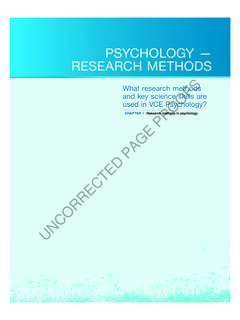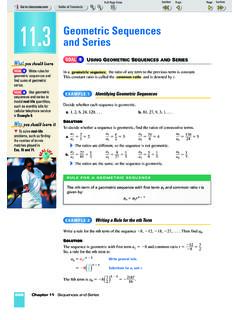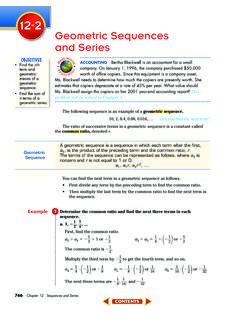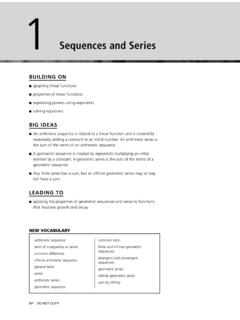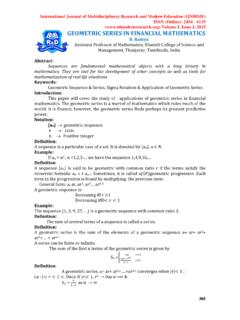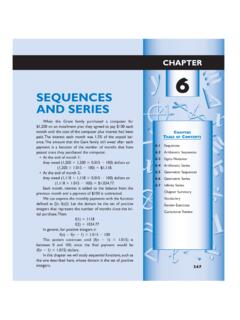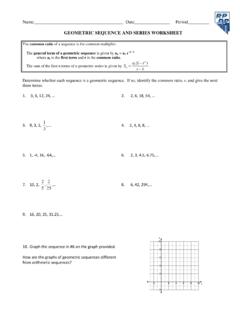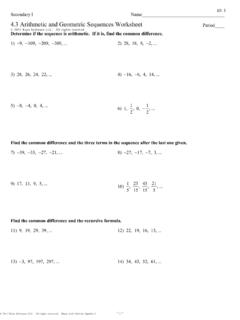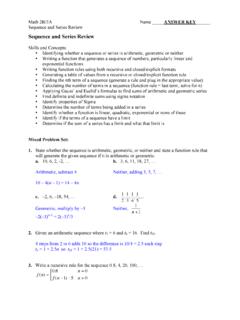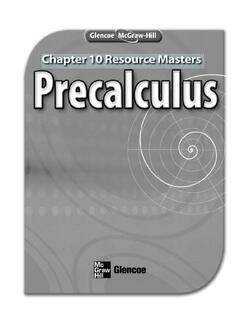Transcription of Sequences and series - Wiley
1 3 Sequences and Kick off with Describing Arithmetic Arithmetic geometric geometric Applications of Sequences and Review 10018/06/15 9:56 pmUNCORRECTED PAGE PROOFSP lease refer to the Resources tab in the Prelims section of your eBookPlUs for a comprehensive step-by-step guide on how to use your CAS Kick off with CASTo 10118/06/15 9:56 pmUNCORRECTED PAGE PROOFSD escribing sequencesSequences of numbers play an important part in our everyday life. For example, the following , , , , , ..gives the end-of-day trading price (for 5 consecutive days) of a share in an electronics company. It looks like the price is on the rise, but is it possible to accurately predict the future price per share of the company?The following sequence is more predictable:10 000, 9000, 8100, ..This is the estimated number of radioactive decays of a medical compound each minute after administration to a patient.
2 The compound is used to diagnose tumours. In the first minute, 10 000 radioactive decays are predicted; during the second minute, 9000, and so on. Can you predict the next number in the sequence ? You re correct if you said 7290. Each successive term here is 90% of, or times, the previous are strings of numbers. They can be finite in number or infinite. Number Sequences may follow an easily recognisable pattern or they may not. A great deal of recent mathematical work has gone into deciding whether certain strings follow a pattern (in which case subsequent terms could be predicted) or whether they are random (in which case subsequent terms cannot be predicted). This work forms the basis of chaos theory, speech recognition software for computers, weather prediction and stock market forecasting, to name but a few uses. The list is almost endless. The image on the right is a visual representation of a sequence of numbers called a Mandelbrot that follow a pattern can be described in a number of different ways.
3 They may be listed in sequential order; they may be described as a functional definition; or they may be described in an iterative in sequential orderConsider the sequence of numbers t: {5, 7, 9, ..}. The numbers in sequential order are firstly 5 then 7 and 9, with the indication that there are more numbers to follow. The symbol t is the name of the sequence , and the first three terms in the sequence shown are t1 = 5, t2 = 7 and t3 = 9. The fourth term, t4, if the pattern were to continue, would be the number 11. In general, tn is the nth term in the sequence . In this example, the next term is simply the previous term with 2 added to it, with the first term being the number possible sequence is t: {5, 10, 20, 40, ..}. In this case it appears that the next term is twice the previous term. The fifth term here, if the pattern continued, would be t5 = 80. It can be difficult to determine whether or not a pattern exists in some Sequences .
4 Can you find the next term in the following sequence ?t: {1, 1, 2, 3, 5, 8, ..}Here the next term is the sum of the previous two terms, hence the next term would be 5 + 8 = 13, and so on. This sequence is called the Fibonacci sequence and is named after its discoverer Leonardo Fibonacci, a thirteenth century is another sequence ; can you find the next term here?t: {7, 11, 16, 22, 29, ..} MATHS QUEST 11 SPECIALIST MATHEMATICS VCE Units 1 and 10218/06/15 9:56 pmUNCORRECTED PAGE PROOFSIn this sequence the difference between successive terms increases by 1 for each pair. The first difference is 4, the next difference is 5 and so on. The sixth term is thus 37, which is 8 more than definitionA functional definition of a sequence of numbers is expressed in the form:tn = 2n 7, n {1, 2, 3, 4, ..}Using this definition the nth term can be readily calculated. For this example t1 = 2 1 7 = 5, t2 = 2 2 7 = 3, t3 = 2 3 7 = 1 and so on.
5 We can readily calculate the 100th term, t100 = 2 100 7 = 193, simply by substituting the value n = 100 into the expression for at the following example:dn = , n {1, 2, 3, ..}For this example, in which the sequence is given the name d, d1 = 12 = , and d2 = 22 = Listing the sequence would yield d: { , , , , ..}. The 10th term would be 102 = is another example:cn = cos (n ) + 1, n {1, 2, 3, ..}Here the sequence would be c: {0, 2, 0, 2, ..}.Recursive definitionA sequence can be generated by the repeated use of an instruction. This is known as recursion. Term n is represented by tn; the next term after this one is represented by tn + 1, while the term before tn is tn 1. For these Sequences , the first term must be at the following example:tn + 1 = 3tn 2; t1 = first term, t1, is 6 (this is given in the definition), so the next term, t2, is 3 6 2 = 16, and the following term is 3 16 2 = 46.
6 In each and all cases the next term is found by multiplying the previous term by 3 and then subtracting 2. We could write the sequence out as a table:ntnComment1t1 = 6 Given in the definition2t2=3t1 2=3 6 2=16 Using t1 to find the next term, t23t3=3t2 2=3 16 2=46 Using t2 to find the next term, t34t4=3t3 2=3 46 2=136 Using t3 to find the next term, t4An example of this sequence using notation found in a spreadsheet would be:A1 = 6 (the first term is equal to 6)A2 = 3 A1 2 (the next term is 3 times the previous term minus 2).Topic 3 Sequences And series 10318/06/15 9:56 pmUNCORRECTED PAGE PROOFSYou could then apply the Fill Down option in the Edit menu of the spreadsheet from cell A2 downwards to generate as many terms in the sequence as required. This would result in the next cell down being three times the previous cell, less 2. The recursive defi nition fi nds a natural use in a spreadsheet environment and consequently is used often.
7 A drawback is that you cannot fi nd the nth term directly as in the functional defi nition, but an advantage is that more complicated systems can be successfully modelled using recursive Find the next three terms in the sequence : U14, 7, 72, .. Find the 4th, 8th and 12th terms in the following sequence : en = n2 3n, n {1, 2, 3, ..}.c Find the 2nd, 3rd and 5th terms for the following sequence : kn + 1 = 2kn + 1, k1 = this example the sequence is listed and a simple pattern is evident. From inspection, the next term is half the previous term and so the sequence would be 14, 7, 72, 74, 78, next three terms are 74, 78, This is an example of a functional defi nition. The nth term of the sequence is found simply by substitution into the expression en = n2 = n2 3n2 Find the 4th term by substituting n = 3 4=43 Find the 8th term by substituting n = 3 8=404 Find the 12th term by substituting n = 3 12=108c1 This is an example of a recursive defi nition.
8 We can fi nd the 2nd, 3rd and 5th terms for the sequence kn + 1 = 2kn + 1, k1 = by + 1=2kn+1, k1= Substitute k1 = into the formula to fi nd +1=03 Continue the process until the value of k5 is 0+1=1k4=2 1+1=3k5=2 3+1=74 Write the k2 = 0, k3 = 1 and k5 = EXAMPLE111104 MATHS QUEST 11 SPECIALIST MATHEMATICS VCE Units 1 and 10418/06/15 9:56 pmUNCORRECTED PAGE PROOFSL ogistic equationThe logistic equation is a model of population growth. It gives the rule for determining the population in any year, based on the population in the previous year. Because we need the previous term in order to generate the next term of the sequence , the logistic equation is an example of a recursive defi nition. It is of the general formtn + 1 = atn(1 tn)where 0 < t0 < 1 and a is a on the value of a, Sequences generated by use of the logistic equation could be convergent, divergent or oscillating.
9 A string of numbers that converges to (settles at) a certain fi xed value is called a convergent sequence . A sequence tn can converge to only one possible number, x, called the limit of the sequence . This can be written as tn x. (In this context the symbol is read as tends to or approaches .) A sequence whose terms grow further and further apart is called divergent. That is, a sequence is divergent if tn or tn as n . Finally, a sequence whose terms tend to fl uctuate between two (or more) values is called oscillating. An oscillating sequence is neither convergent nor that a = 2 and t0 = , use the logistic equation to generate a sequence of 6 terms and state whether the sequence is convergent, divergent or oscillating. If the sequence is convergent, state its Write the logistic equation, replacing a with its given value (that is, 2).tn + 1=atn(1 tn)=2tn(1 tn)2 To fi nd t1, substitute the value of t0 (that is, ) in place of tn and (1 t0)=2 (1 )= To fi nd the next term, t2, substitute the value of t1 (that is, ) in place of tn and (1 t1)=2 (1 )= Continue the iterative process four more times, each time substituting the value of the previous term into the logistic equation to fi nd the next (1 t2)=2 (1 )= 672 3t4=2t3(1 t3)=2 672 3 (1 672 3)= 999 8t5=2t4(1 t4)=2 999 8 (1 999 8)= (1 t5)=2 (1 )= The terms of the sequence are growing closer and closer to each other, fi nally settling at sequence is convergent.
10 The limit of the sequence is EXAMPLE222 Topic 3 Sequences And series 10518/06/15 9:56 pmUNCORRECTED PAGE PROOFSNote that instead of saying the limit of the sequence is in the previous example, we could simply write tn sequences1 WE1 a Find the next three terms in the sequence : U3, 32, 34, .. Find the 2nd, 4th and 6th terms in the following sequence : tn=4 3n 2, n 51, 2, 3, .. Find the 2nd, 3rd and 5th terms for the following sequence : kn + 1=kn+2, k1= a Find the next three terms in the sequence : 52, 5, 8, 11, 14, .. Find the 4th, 8th and 12th terms in the following sequence : tn=n2 n+41, n 51, 2, 3, .. Find the 2nd, 3rd and 4th terms for the following sequence : kn + 1= Qkn2R 2, k1= WE2 Given that a = and t0 = , use the logistic equation to generate a sequence of 6 terms and state whether the sequence is convergent, divergent or oscillating. If the sequence is convergent, state its Given that a = and t0 = , use the logistic equation to generate a sequence of 6 terms and state whether the sequence is convergent, divergent or oscillating.








